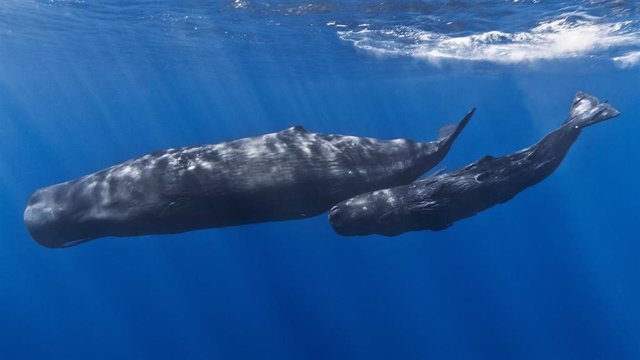sperm whales – GABRIEL BARATHIEU/FLICKR
July 15 () –
Scientists have started a five-year multidisciplinary project to decipher communications similar to Morse code of sperm whales on the Caribbean island of Dominica.
This is the Cetacean Translation Initiative (CETI), a project that seeks to obtain a deeper understanding of the most intelligent predators in the ocean and to preserve their habitat from further human disturbance.
With scientists from 16 different research agencies, CETI is estimated to be the largest interspecies communication effort in history.
“We are dealing with a completely unknown form of communication, and data collection can be challenging,” he explains. it’s a statement Gaspar Begus, assistant professor of linguistics in the UC Berkeley Social Sciences Division and director of the Berkeley Speech and Computing Laboratory.
CETI’s engineering team is building a drone system that will automatically tag whales and record their vocalizations and other parameters, such as orientation, speed and temperature.
Predating humans on Earth by some 15 million years, sperm whales’ gigantic brains give them the neural capacity for planning, sophisticated communication, and social interactions that last for decades. Their silvery bodies of more than 30 tons store carbon and play a secondary role in cooling the earth.
Sperm whales are organized into large matrilineal families and clans, with each group identifying with its own distinctive dialect. Their powerful clicking sounds are emitted through a mixture of organs known as spermaceti that sit on top of their skulls. Whales’ sound patterns are learned, not innate, like a dog’s barkBegus said.
Their deep ocean habitats are threatened by noise pollution, climate change, commercial fishing, and military activities including underwater explosions and sonar technology.
If left to die naturally, sperm whales sink to the ocean floor, taking with them carbon stored in their bodies that would otherwise have been released into the atmosphere if the whales had been hunted and brought ashore. In addition, the droppings of the whales contribute to the growth of phytoplankton, which is estimated to capture about 40% of all carbon dioxide produced.
“If we get to know sperm whales better by learning their communication and the full scope of their cognitive and social life, it becomes more difficult for us as a species to treat them as non-sentient beings and destroy them,” Begus said.
In their respective labs at UC Berkeley, Begus and computer scientist Shafi Goldwasser, winner of the prestigious AM Turing Award, are using artificial intelligence, including deep-fake technology, to identify linguistic patterns. on recordings of what could eventually amount to billions of sperm whale clicks.
“In the case of translation from one human language to another, a ‘Rosetta stone’ is often available, making it a so-called supervised language translation problem. And even when such examples are not known, at least we have a good sense of what the general themes and the context in which the conversations take place may bein order to detect when a proposed translation doesn’t make sense,” said Goldwasser, who at UC Berkeley is director of the Simons Institute for the Theory of Computing and professor of electrical engineering and computer science.
“For CETI,” he added, “we need to significantly extend the theory and practice of unsupervised language translation, where correct translation examples are not given, to an environment where our prior knowledge about what the whales may be communicating is limited, and we can’t run controlled experiments New methods for modeling what the whales are communicating will guide us when we’re making progress on the translation task or, alternatively, discard the proposed translations”.
As with any unknown form of communication, the sounds sperm whales make to communicate with each other and navigate through echolocation are fraught with enigmas. The unknown in the sperm whale communication system is not just what the codas mean, but also how we test and confirm what we think they mean.
To address these questions, the team will take advantage of new advances in artificial intelligence (AI). Begus is developing AI models that learn human speech in a way similar to how children learn language: unsupervised, without text, and by imitation and imagination. Along with his team at the Berkeley Speech and Computing Laboratory, is testing whether models that learn human language from speech can also learn the sperm whale’s communication system.
Meanwhile, other CETI collaborators from more than a dozen research institutions around the world are working on other areas of the project, including setting up a network of underwater microphones, drones, and robotic fish to stealthily track and record communication from the sperm whales
His research is published in iScience.




![[Img #74662]](https://thelatestnews.world/wp-content/uploads/2024/12/Organisms-with-the-shortest-life-150x150.jpg)








![[Img #74662]](https://thelatestnews.world/wp-content/uploads/2024/12/Organisms-with-the-shortest-life-300x200.jpg)


Add Comment